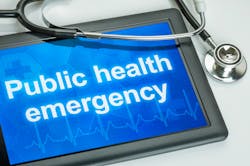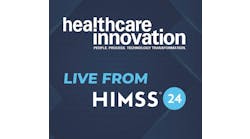An epidemiologist and a physician, both leaders in public health, on January 1 penned a “Perspective” op-ed column in The New England Journal of Medicine online, in which they bemoan the current patchwork state of public health management in the United States, and call for governance and management reform.
In their article, entitled “The Patchwork U.S. Public Health System,” Megan Wallace, Dr.P.H., and Joshua M. Sharfstein, M.D., examine the current landscape around public health, pointing out its structural deficiencies, and advocate for systemic reform. Megan Wallace is Department of Epidemiology, and Sharfstein, in the Department of Health Policy and Management, both at the Johns Hopkins Bloomberg School of Public Health in Baltimore. “Sharfstein,” who holds the title of vice dean for public health practice and community engagement, “oversees the Office of Public Health Practice and Training, SOURCE (the community engagement and service-learning center) and graduate medical education in Preventive Medicine and Occupational Health. He is also the director of the Bloomberg American Health Initiative and Professor of the Practice in Health Policy and Management. Previously, he served as Commissioner of Health for Baltimore City, Principal Deputy Commissioner of the U.S. Food and Drug Administration and Secretary of the Maryland Department of Health and Mental Hygiene,” his profile on the school’s website notes. Megan Wallace, Dr.P.H., besides holding a professorship at the Johns Hopkins Department of Epidemiology, is also an epidemiologist at the Centers for Disease Control and Prevention (CDC) in Atlanta.
“To begin with,” the authors write, “there is no clear administrative structure that organizes the many federal agencies involved in public health (see table). Twenty-one major federal agencies have a role in pandemic preparedness and response, for example, and more than 100 federal offices have been engaged in work during the Covid-19 pandemic. At the state and local levels, variation is the rule, not the exception. Twenty-nine state health departments stand alone, and the others are part of larger health and human services agencies. About half of states have a board of health to provide guidance for public health activities; in the other half, no such board exists. About two thirds of state health officials are appointed by the governor, and the other third are appointed by the secretary of the larger human services agency, a state public health board, or some other entity.”
What’s more, they write, “Similarly, there is little consistency in the relationships between state and local health departments. In 7 states, the state health department operates all local health offices; in 30 states, local health departments operate largely without state control; and in the remainder, various amounts of collaboration occur. A 2012 review noted the challenge of classification: “Even in states that are considered centralized, it is not uncommon for local government entities to exhibit some authority; likewise, in some decentralized states, state government has some powers regarding the local health unit.” They note that “There are about 2800 local health departments in the United States, most of which serve fewer than 50,000 people. About half of local health departments report to a local board of health, which may be an elected body such as a county council or an independently appointed group. Another 20% work with the local board of health in an advisory capacity.”
Furthermore, “The activities undertaken by health departments also vary. In 1994, the U.S. Department of Health and Human Services convened the Core Public Health Functions Steering Committee to define the 10 Essential Public Health Services, a list that was recently updated by a coalition of public health groups (see box) to center equity and include addressing structural causes of poor health, including poverty, racism, and gender discrimination. The federal agencies and state health departments have broad responsibilities, but typically, local health departments perform less than half of vital public health activities. Nearly all local health departments report that they respond to outbreaks of infectious disease (including foodborne disease), support childhood immunization programs, and participate in community health assessments. However, one fifth of local health departments do not offer tobacco prevention programs, more than half do no work to prevent opioid addiction, three fifths do not offer programs to prevent chronic diseases, and nearly two thirds do not conduct surveillance on injuries.”
So, what to do about this lack of system-ness in the U.S. healthcare system? Wallace and Sharfstein see
Key areas to focus on in terms of reforming all of this: digitizing public health and connecting systems through interoperability; repairing the “chronic underfunding” that has plagued public health in the U.S. for many years; addressing the public health workforce crisis; and “strengthen[ing] state and local public health agencies by means of accreditation.”
With regard to data, information, and interoperability, Wallace and Sharfstein write that, “Although information technology and data capacity are key to public health capacity, much of state and local public health work remains based on paper, with large gaps in the ability of health departments to obtain, analyze, and share information expeditiously. More than one third of local health departments are unable to access an electronic surveillance system with data from local emergency departments, which could facilitate early identification of illnesses of concern, including foodborne illness. Only 3% of local health departments reported that their information systems are all interoperable, a limitation that hampers both daily prevention work and coordinated responses. Complicating this picture further is a lack of systematic collection of data in critical areas, such as data on race and ethnicity needed to track disparities and equity.”
But the authors also hammer home the fundamental crisis of public health funding, noting that, “Before the pandemic, funds for public health represented less than 3% of health care expenditures in the United States. This imbalance in support persisted despite the worst public health catastrophe in a century. In early 2020, Congress provided $178 billion to support the health care system, even as many health departments could not scale their efforts or were forced to lay off workers. This disparity exposed the long-standing dynamic whereby powerful interests in health care can make their needs clear to policymakers, while public health agencies, which have much less visibility, rarely succeed in inspiring essential investments in disease control and prevention.”
What’s more, they note, “Political polarization has complicated matters further,” citing the current crisis around disinformation with regard to the COVID-19 pandemic, emphasizing that “Health leaders supporting evidence-based public health measures such as mask mandates have experienced unprecedented levels of harassment, intimidation, and threats. Hundreds of public health officials across the United States have been fired or have resigned, and 32 states have adopted new laws limiting public health authority during emergencies.”
Ironically, they note, it is in the middle of the greatest public health crisis of our lifetimes that the greatest opportunity to implement change also exists. As they conclude, “As the pandemic’s impact wanes, the window of opportunity may start to close. The powerful desire to return to “normal” quickly, however, will not erase the fact that the United States relies on a patchwork public health system at its own peril. Only with a major and sustained upgrade to the national public health infrastructure will a salmonella outbreak at a food-safety summit be just an ironic news story, and not also a metaphor for the distance between the aspirations and the reality of health in the United States.”


